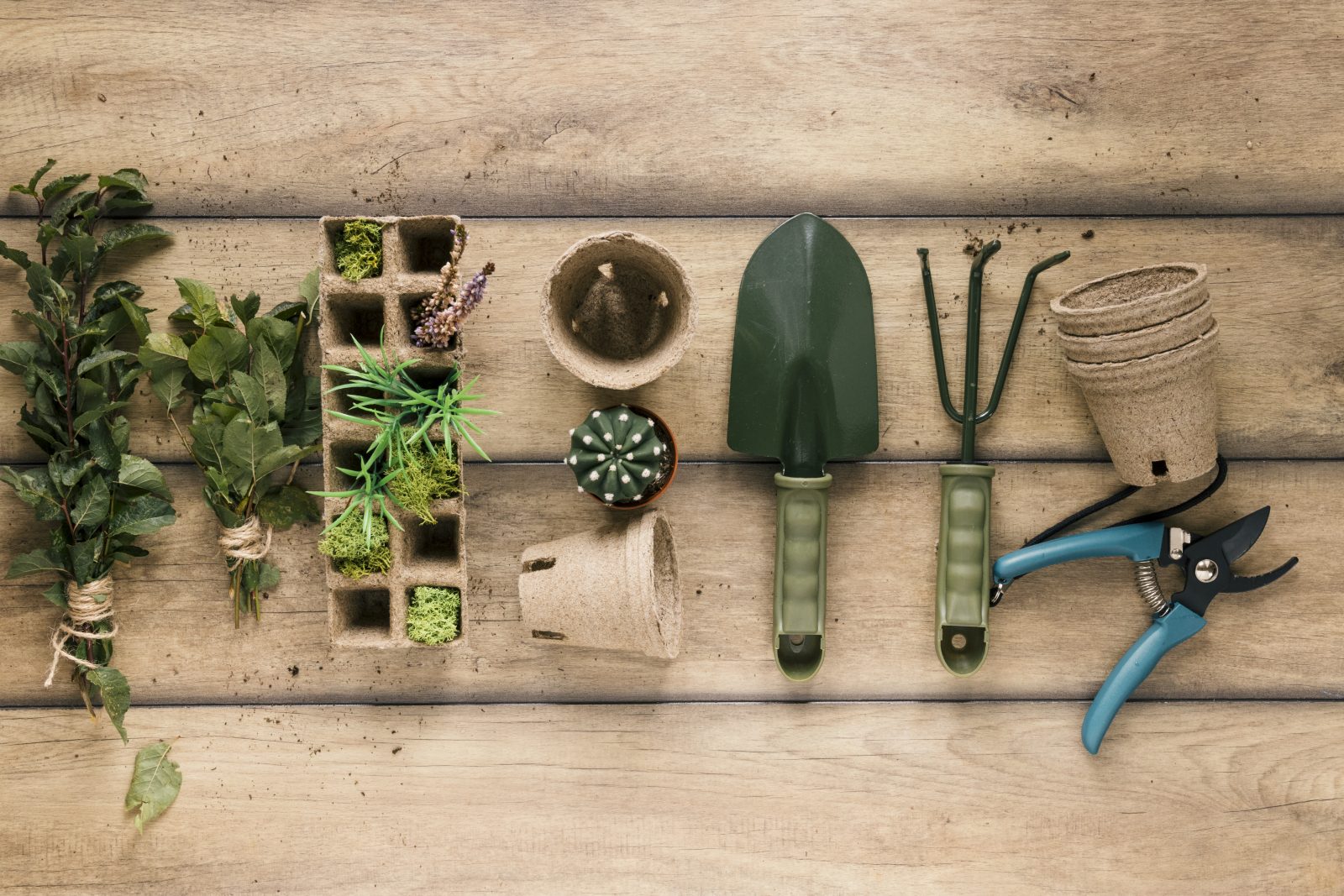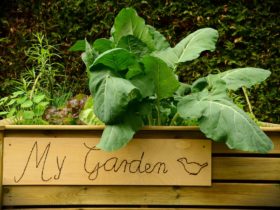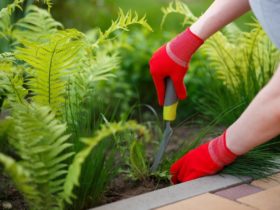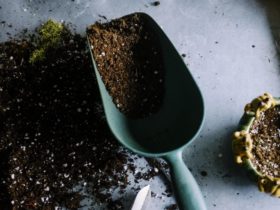Looking for the right tool to use for the job? Check out our comprehensive tools list to see what it is, and what it’s used for!
- Apex Shed -
An apex shed is a workspace in which gardeners can relax, store gardening equipments, or even start some plants. The roof of apex sheds are designed so that tall people can easily enter.
- Border Spade -
The border spade tool is similar to a general spade, but it is smaller. The border spade has a thinner and flatter blade. It is mostly used in landscaping or when transplanting perennials.
- Bow Rake -
The bow rake has a metal frame that is bow-shaped, so it absorbs more pressure and is suitable for heavier jobs. The bow-rake will not snap when used to loosen compacted soil or gathering heavy materials. It can also be used to gather leaves, spread compost, and other gardening activities.
- Bow Saw -
A saw with an arched frame connected to a straight saw, making it look like a bow. This saw can cut branches 6-10cm wide. The tension of this saw can be adjusted to match the item to be cut.
- Budding Knife -
This knife is smaller than normal kitchen knives. It mostly comes with a spatula at the other end. Budding knives are used to cut the rootstock of plants above the bud.
- Cultivators -
A cultivator is a machine with teeths that are dragged through the soil to loosen the soil. The teeth of cultivators can be dragged linearly or by rotatory motion. The major purpose of cultivators is to till the soil.
- Edgers -
Edgers or lawn trimmers are machines that help create boundaries between a lawn and a path. Edgers can be motorized or manual. Edgers keep a path clear from the grass in the lawn.
- Flat Rake -
Flat rakes, or level-headed rakes are rakes with flat rectangular heads with (usually) more than 10 teeth. These rakes are effective for leveling the soil, clearing debris, spreading soil, fertilizer, and compost, etc.
- Gloves -
Gloves are essential gardening accessories that protect your hands from dirt, sunburn, cuts, blisters, and other harms. There are different kinds of gloves for different gardening practices.
- Hand Cultivator -
This little tool is very helpful. You can use hand cultivators to spread soil, compost, loosen compacted soil, and do so much more gardening practices. It is easy and safe to use. It does not cut the root of plants.
- Hedge Shears -
Hedge shears are used to trim and evenly shape shrubs and hedges as opposed to pruning. They feature two sharp blades which act in a scissor motion when the handles are opened and closed. A number of sizes are available to buy with different power source options.
- Hose -
There are so many different models available that buying a garden hose now involves some thought into its main uses and over what area. Lengths can reach from 20 to 120 feet with an endless number of fittings, nozzles, and adapters. There are wall mounted hoses, coiled hoses, hoses designed to withstand freezing temperatures, and hoses with rewind assistance.
- Knives -
Garden knives (or simply knives) are small handy tools used in various gardening activities such as pruning, cutting, weeding, transplanting, grafting, etc. Kitchen knives can be used, but garden knives are recommended in the garden
- Lawnmower -
Lawnmowers are machines that people use to cut grass to even their height. Lawnmowers keep grass from growing uncontrollably in a land. Lawnmowers can be electrical or gas-powered. Some lawnmowers can be ridden on.
- Leaf Blower/Garden Vacuum -
Leaf blowers are machines used to blow or suck leaves off a lawn, path, garden, or walkway. The garden vacuum that suck leaves make the leaves pass through a shredder and enter a collection sack. Lawnmowers can be electrical or gas-powered.
- Leaf Rake -
This is a popular tool used in lawns and gardens to gather (or remove) dead leaves, spread manure and soil, etc. Leaf rakes have about twenty tines with ends pointed to the ground. The times are evenly spread so as to reach a wider area. Most leaf rakes come with long handles.
- Log Cabin -
Log cabins are outdoor structures typically made of wood. They offer some gardening activities as well as leisure. Log cabins can be used as resting places or as storage locations.
- Loppers -
Loppers are a combination of hedge and pruning shears. Loppers are used to cut twigs and branches (small or large). The blade of loppers resembles that of pruning shears while lopper handles resemble the handles of a hedge. Loppers usually come with extendable handles.
- Machete -
Machetes are large heavy knives (similar to swords) mostly used as tools in gardening to clear bushes and cut branches. Machetes are heavier and broader than swords, but very effective in gardening. It is a manual tool that requires strength.
- Manual Edger -
A tool with a round blade attached to a long handle (or shaft) used to remove excess grass from the edge of the lawn (i.e. between the lawn and a path). Manual edgers, as their name imply, requires your physical effort because you have to walk and push the edger for it to cut the grass.
- Pitchfork -
This tool looks like a trident, but has two to five tines. Its use in gardening and similar to a leaf rake. It is used to gather loose materials like leaves and dirt. It can also spread soil, compost, and other materials. It comes with a long handle.
- Potato Fork -
This fork is designed for potatoes. It typically has tines with round ends (or buds) that will not penetrate or slice potatoes as you lift it, but will pass by (i.e. not through) the potatoes. Potato forks usually have 5-9 times.
- Potting Shed -
Potting sheds are shed with part (or half) of their roof being transparent. Gardeners start plants in potting shed as it is more conducive for plants. People also store some gardening tools in potting sheds.
- Powered Chainsaw -
This is a machine with a saw that can cut through branches, wood, and even full trees depending on its size. It is usually powered by batteries, electricity, or gas. You need to be careful when operating a powered chainsaw.
- Powered Edger -
As the name suggests, the powered edger is a machine that helps define the edges of a lawn. You can use a powered edger to remove any grass that is growing into a path (outside the lawn). Powered edges are usually powered by electricity or gas. Remember to wear goggles so debris do not reach your eyes.
- Pressure Washer -
This machine adds pressure to the flow of water so that dirt on a surface will be swept away by the water. Pressure washers are safe for wooden, metal, plastic, and even concrete surfaces. The machine can be powered by electricity or gas.
- Pruning Knife -
A knife with a curved blade that fits flower stems, young plant stocks and branches. Some pruning knives have blades that can be folded (for safety) while others are not foldable.
- Pruning Saw -
This tool has a tapered blade that is either curved or straight. Some models are foldable for safety. It is used to cut small branches.
- Pruning Shears -
A scissor-like tool that is hand-held and used to cut slim branches of shrubs and small trees. This tool has blades that are a bit curved for better grip of the branch. It is used in gardening.
- Rotary Tiller -
These machines are similar to hand cultivators, but on a larger scale. Rotary tillers help to till soil and mix the soil with fertilizer, compost, and other soil amendments. The tiller can be removed so that something else can be attached to the machine to carry out other functions such as grass cutting.
- Round Point Shovel -
As the name suggests, a round point shovel with a round and bowl-like head. The edge of its head is round to a point at the middle so that it can easily dig into the soil. The head is also bowl-shaped so that it can serve as a scoop to carry soil. This tool can carry heavy materials without breaking
- Saws -
A saw is a tool with a tapered blade. Saws can come in form of handsaws that have a bow-like frame that holds the blades or a chainsaw which rotates the blades with the help of an engine. You should use a saw with care as it can cut through so many surfaces including wood, metals, and plastics.
- Scoop Shovel -
This shovel has a large and deep head that is suitable for moving materials from one place to the next. Scoop shovels are not recommended for heavy materials because their handles can break easily, so restrict the use to snows, sawdust, compost, etc.
- Scuffle Hoe -
This tool is similar to a garden hoe, but has sharpened (mostly square) edges. It can be used to uproot shallow-rooted weeds. While the tool can be used when moving either forward or backward, it is more effective when moving backwards.
- Shears -
Scissor-like tools that are hand-held and used to cut and shape plants. Shears are larger than scissors. They are used by gardeners, farmers, landscapers, and so many others.
- Sheds -
Sheds are structures that serve various purposes including extending seasons, storing seeds and tools, relaxing, etc. Sheds are mostly made of wood. Some sheds have part-transparent glasses to allow sunlight to reach seedlings growing inside.
- Shovel -
A shovel is a hand-tool used to dig and list materials. As a gardening tool, shovels can till the soil, spread soil and compost, uproot weeds, and perform so many functions. Shovels are a must-have for every gardener.
- Shredder -
Shredders are machines used to shred materials into smaller pieces. Shredders can be used to shred leaves, paper, small branches, etc. Shredded materials can be used as compost and mulch. Shredders also make materials easy to contain and dispose.
- Spades -
A spade is a digging tool that looks like a shovel. Spades are less curved than shovels. In gardening, spades can be used to dig, till, apply soil and fertilizer, uproot weeds, etc. Almost every gardener owns a spade.
- Spading Fork -
The spading fork is a spade with tines just like a fork. It is recommended for transplanting perennials, succulents, and plants with tender roots because it will not cut the roots of the plant while digging. It is not very effective at spreading soil and compost, but still can be used.
- Square Point Shovel -
Square point shovels are spades with elevated edges that can hold soil and other materials on the shovel from falling. Square point shovels are recommended for scooping and transfering materials because they can hold more materials with their edges
- Transplant Spade -
These spades are recommended for perennials. They can dig the soil and lift the plant (for transplanting) without harming most of the roots. Transplant spades are similar to border spades, but have a thinner and longer blade.
- Trowel -
Trowels are small hand-held tools mostly used in container gardening. They are used to transplant seedlings, flowers, perennials, dig holes, and perform other gardening activities. Trowels are shovel-like, but way smaller. Trowels can be used in small areas, hence their use in container gardening.
- Warren Hoe -
This is a type of hoe with a blade that is triangle-shaped. It is mostly used when uprooting root vegetables such as potatoes, leeks, etc. It can also be used to replace hoes and trowels if need be.
- Watering Can -
This is a container used to water plants. Watering cans can pour drops of water to the roots and leaves of plants. Watering cans are suitable for small gardeners. People who have large gardens should use irrigators.
- Weeder -
Weeders are small tools used in lawns to remove weed without damaging grass. They are conventionally small and screwdriver-shaped, but can come in various shapes and sizes. Since weeders can only remove plants that grow tall and leave short grasses, they are not recommended in gardens.
- Wheelbarrow -
A small pushing cart with one wheel at the front and two supporting handles at the back. Wheelbarrows are a must-have for gardeners because they can help transport seeds, seedlings, soil, compost, tools, and other materials.










Leave a Reply